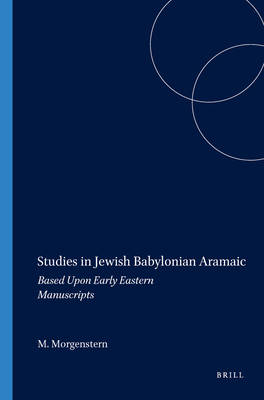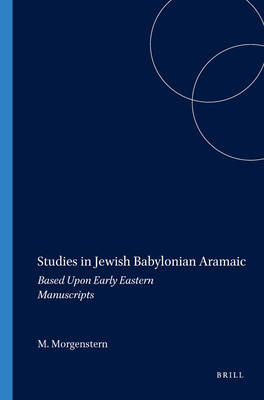
En raison d'une grêve chez bpost, votre commande pourrait être retardée. Vous avez besoin d’un livre rapidement ? Nos magasins vous accueillent à bras ouverts !
- Retrait gratuit dans votre magasin Club
- 7.000.000 titres dans notre catalogue
- Payer en toute sécurité
- Toujours un magasin près de chez vous
En raison de la grêve chez bpost, votre commande pourrait être retardée. Vous avez besoin d’un livre rapidement ? Nos magasins vous accueillent à bras ouverts !
- Retrait gratuit dans votre magasin Club
- 7.000.0000 titres dans notre catalogue
- Payer en toute sécurité
- Toujours un magasin près de chez vous
91,95 €
+ 183 points
Description
This book is the first wide-ranging study of the grammar of the Babylonian Aramaic used in the Talmud and post-Talmudic Babylonian literature (henceforth: Rabbinic Babylonian Aramaic) to be published in English in a century. The book takes as its starting point the long-recognized problem of the corrupt nature of the later textual witnesses of Babylonian Rabbinic literature and seeks both to establish criteria for the identification of accurate textual witnesses and describe the grammar of Rabbinic Babylonian Aramaic. The book is both programmatic and descriptive: it lays the foundations for future research into the dialect while clarifying numerous points of grammar, many of which have not been discussed systematically in the available scholarly literature.
Following a critical survey of the currently available scholarly tools, the book considers the rôle of the Yemenite textual and reading traditions in the study of Rabbinic Babylonian Aramaic. While some previous authorities have regarded this tradition as a primary source for grammatical study of the dialect, by comparing the data of the earliest manuscripts to the forms employed in the Yemenite traditions, the present book demonstrates that the Yemenite traditions have been subject to secondary changes. Accordingly, it is concluded here that only the early eastern manuscripts preserve the dialect in its original form.The next chapter considers the problem of linguistic variation within the corpus. It is well established that the Talmudic literature employs a wide range of alternative grammatical forms. Several explanations have been proposed for this phenomenon. Some authorities have suggested that it arises from dialectal differences, while others have proposed that it represents the use of different literary registers. An alternative explanation is that the language was altered during the course of textual transmission. This study shows that none of these explanations can account for the wide extent of the phenomenon, which is found in the best textual witnesses and in ostensibly uniform contexts. It is argued that all of proposed explanations may partially account for the interchanges but, ultimately, the lack of a literary standard leads to the use of different forms.
Syntax is often regarded as being one of the linguistic areas least affected by textual transmission. However, the early manuscripts show that Rabbinic Babylonian Aramaic employs a defined series of syntactic structures to mark the direct object. This clearly defined complimentary distribution is lost in the later textual witnesses, which use the structures interchangeably. It is thus shown that, for syntactic study, too, only a small group of textual witnesses can be regarded as reliable.
Following a critical survey of the currently available scholarly tools, the book considers the rôle of the Yemenite textual and reading traditions in the study of Rabbinic Babylonian Aramaic. While some previous authorities have regarded this tradition as a primary source for grammatical study of the dialect, by comparing the data of the earliest manuscripts to the forms employed in the Yemenite traditions, the present book demonstrates that the Yemenite traditions have been subject to secondary changes. Accordingly, it is concluded here that only the early eastern manuscripts preserve the dialect in its original form.The next chapter considers the problem of linguistic variation within the corpus. It is well established that the Talmudic literature employs a wide range of alternative grammatical forms. Several explanations have been proposed for this phenomenon. Some authorities have suggested that it arises from dialectal differences, while others have proposed that it represents the use of different literary registers. An alternative explanation is that the language was altered during the course of textual transmission. This study shows that none of these explanations can account for the wide extent of the phenomenon, which is found in the best textual witnesses and in ostensibly uniform contexts. It is argued that all of proposed explanations may partially account for the interchanges but, ultimately, the lack of a literary standard leads to the use of different forms.
Syntax is often regarded as being one of the linguistic areas least affected by textual transmission. However, the early manuscripts show that Rabbinic Babylonian Aramaic employs a defined series of syntactic structures to mark the direct object. This clearly defined complimentary distribution is lost in the later textual witnesses, which use the structures interchangeably. It is thus shown that, for syntactic study, too, only a small group of textual witnesses can be regarded as reliable.
Spécifications
Parties prenantes
- Auteur(s) :
- Editeur:
Contenu
- Nombre de pages :
- 312
- Langue:
- Anglais
- Collection :
- Tome:
- n° 62
Caractéristiques
- EAN:
- 9781575069388
- Date de parution :
- 01-01-11
- Format:
- Livre broché
- Format numérique:
- Trade paperback (VS)
- Dimensions :
- 155 mm x 235 mm

Les avis
Nous publions uniquement les avis qui respectent les conditions requises. Consultez nos conditions pour les avis.






